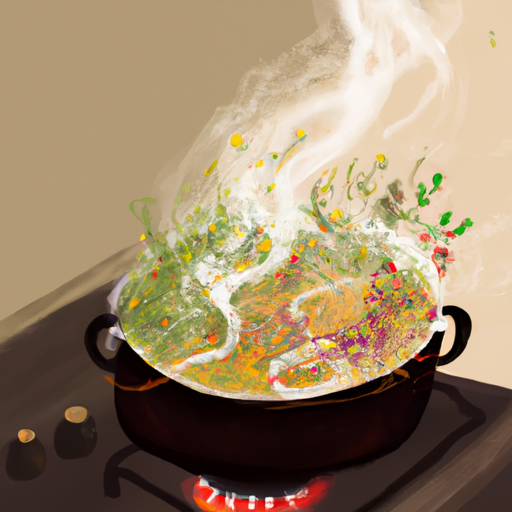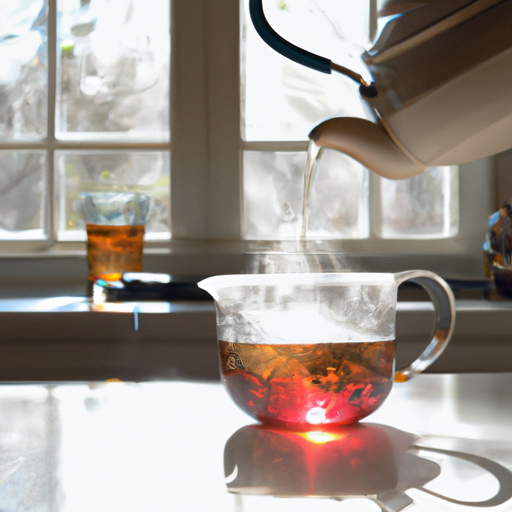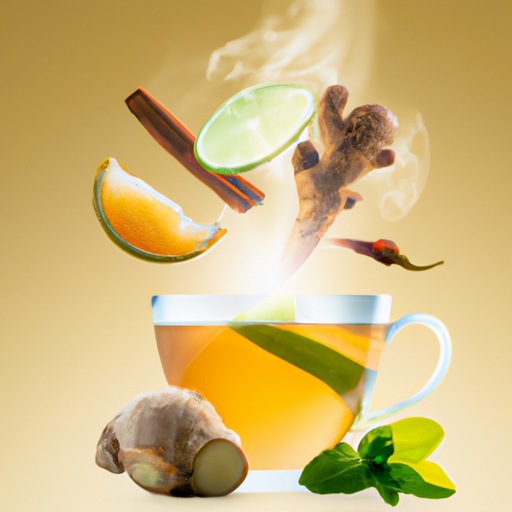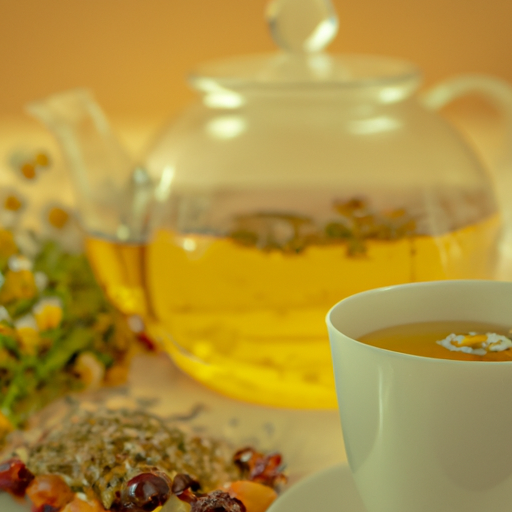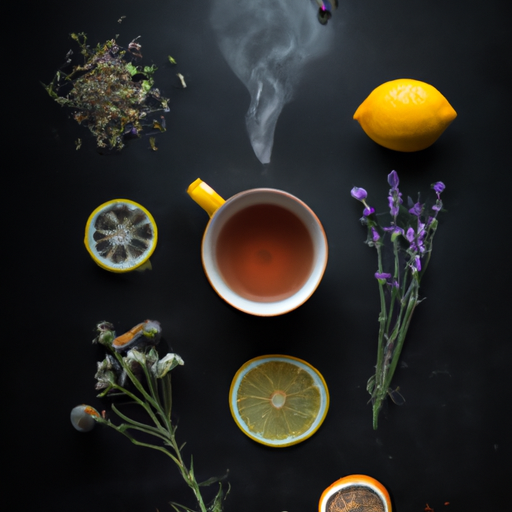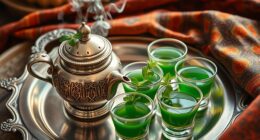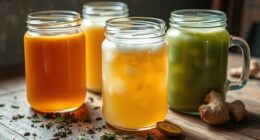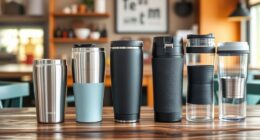Have you ever had a craving for a warm and comforting drink that not only tastes amazing but also provides numerous health benefits? Look no further than brewing herbal tea in a pot. This traditional and respected method of making tea is not just a pleasant ritual, but also a fantastic way to take advantage of the medicinal qualities of herbs.
In this article, I will guide you through the process of making herbal tea in a pot, step by step. From selecting the perfect herbal blend to steeping it to perfection, I will share my knowledge and expertise to ensure that you create a cup of tea that is both comforting and nourishing.
So grab your favorite teapot, gather your ingredients, and let’s embark on a journey of flavor and wellness. Get ready to indulge in the aromatic and holistic experience of homemade herbal tea.
Key Takeaways
- Choose high-quality, organic leaves for a flavorful cup of herbal tea
- Select a teapot made from heat-resistant materials like glass or ceramic
- Infuse aromatic herbs into hot water for a soothing and revitalizing cup of tea
- Customize herbal tea with natural sweeteners, lemon slices, mint, or spices
Gather Your Ingredients and Tools
Gather all your ingredients and tools in one place, creating a delightful array of fragrant herbs, a teapot, and a strainer, ready to embark on your herbal tea-making adventure.
Choosing the right tea leaves is crucial for a delicious cup of herbal tea. Opt for high-quality, organic leaves that are free from pesticides and additives. Popular options include chamomile, peppermint, and lavender, each offering unique flavors and health benefits. Experiment with different combinations to find your perfect blend.
Next, finding the perfect teapot is essential. Look for one that’s made from heat-resistant materials like glass or ceramic, as this’ll ensure that the flavors of your herbs are preserved. A teapot with a built-in strainer or a separate strainer will make it easier to separate the leaves from the liquid, resulting in a smoother cup of tea.
Now that you have gathered your ingredients and tools, it’s time to choose your favorite herbal tea blend. From calming chamomile to refreshing mint, there are countless options to explore. Consider your mood, taste preferences, and any specific health benefits you’re seeking. Once you have selected your blend, let’s move on to the next step: brewing your herbal tea in a pot.
Choose Your Favorite Herbal Tea Blend
Once you’ve selected your preferred herbal tea blend, you’ll be delighted to know that approximately 87% of tea enthusiasts agree that it enhances the overall tea-drinking experience.
Herbal tea blends come in a wide variety, each with its own unique taste and benefits. Here are four popular types of herbal tea blends to choose from:
-
Chamomile: Known for its calming properties, chamomile tea is perfect for winding down after a long day. It can help promote relaxation and improve sleep quality.
-
Peppermint: With its refreshing and invigorating flavor, peppermint tea is great for soothing an upset stomach and relieving digestive issues. It also provides a natural burst of energy.
-
Rooibos: Also known as red tea, rooibos tea is packed with antioxidants and is caffeine-free. It can help boost the immune system and promote healthy skin.
-
Ginger: Ginger tea has a spicy and warming taste. It’s well-known for its anti-inflammatory properties and can aid in digestion and relieve nausea.
Drinking herbal tea has numerous benefits, including improved digestion, reduced inflammation, and enhanced relaxation.
Now that you’ve chosen your favorite herbal tea blend, let’s move on to preparing the pot and water for brewing.
Prepare the Pot and Water
Get ready to elevate your tea-drinking experience by preparing your trusty teapot and fresh water. When making herbal tea in a pot, it is crucial to choose the right tea leaves and ensure the water temperature is perfect.
Choosing the right tea leaves is essential for a flavorful cup of herbal tea. There are countless options available, each with its unique taste and benefits. Whether you prefer the soothing aroma of chamomile or the invigorating flavor of peppermint, selecting your favorite blend will enhance your tea-drinking experience.
Now, let’s talk about the importance of water temperature. The ideal temperature for brewing herbal tea is typically lower than that of black or green tea. Boiling water can scorch the delicate leaves and result in a bitter taste. To achieve the perfect temperature, refer to the packaging instructions or use a thermometer. Generally, a temperature between 180°F (82°C) and 205°F (96°C) works well for most herbal teas.
With your teapot prepared and fresh water at the optimal temperature, you’re ready to add the herbal tea and steep. Transitioning seamlessly into the next step, we will explore the art of steeping herbal tea to extract its full flavor and goodness.
Add the Herbal Tea and Steep
Now, it’s time to infuse your chosen blend of aromatic herbs into the hot water, allowing their flavors to intertwine and create a soothing and revitalizing cup of tea.
Herbal tea is not only a delightful beverage but also a wonderful way to support your overall health and wellness. The benefits of herbal tea are vast, ranging from boosting the immune system to aiding digestion and promoting relaxation. Each type of herbal tea possesses its own unique flavors and properties, making the experience of trying different blends a truly enjoyable one.
For example, chamomile tea is known for its calming properties, while peppermint tea can soothe an upset stomach. By exploring the variety of herbal teas available, you can find the perfect blend that suits your taste and addresses your specific health needs.
So, now that the herbs have steeped in the hot water, it’s time to move on to the next step: straining and serving your delicious herbal tea.
Strain and Serve
Pour the infused blend of aromatic herbs into a cup through a strainer to ensure a smooth and flavorful serving of your revitalizing beverage. Straining the herbal tea is an essential step in the preparation process, as it removes any loose leaves or particles, resulting in a more enjoyable drinking experience.
There are different methods you can use to strain your herbal tea, depending on your preference and the tools you have available. Some common methods include using a fine mesh strainer, a tea infuser, or even a coffee filter. Experiment with different methods to find the one that works best for you.
Serving herbal tea hot or cold provides different benefits and experiences. When served hot, the tea’s warmth can help soothe and relax your body, making it an ideal choice for chilly evenings or when you need a comforting drink. On the other hand, serving herbal tea cold can be incredibly refreshing, especially on hot summer days. Cold herbal tea can also be a great option for those looking to quench their thirst without the need for caffeine or sugary drinks.
Now that you have strained and served your herbal tea, it’s time to move on to the next step: customizing your tea with sweeteners or enhancements.
Customize Your Tea with Sweeteners or Enhancements
Enhance the flavor of your revitalizing beverage by personalizing your tea with a touch of sweetness or other enticing enhancements. When it comes to sweetening herbal tea, there are a variety of options to choose from.
Natural sweeteners like honey, stevia, and maple syrup can add a subtle sweetness without overpowering the herbal flavors. If you prefer a more intense sweetness, you can opt for sugar or agave nectar. It’s important to note that some herbal teas are naturally sweet on their own, so you may not need to add any sweetener at all.
In addition to sweeteners, there are other ways to enhance the flavor of your herbal tea. You can experiment with different ingredients such as lemon or orange slices, fresh herbs like mint or basil, or even spices like cinnamon or ginger. These additions can bring a new dimension to your tea and complement the herbal flavors beautifully.
Once you’ve customized your tea with sweeteners or enhancements, it’s time to sit back, relax, and enjoy your homemade herbal tea. The aroma and taste will transport you to a place of tranquility and well-being. So, take a moment for yourself, savor the flavors, and let the soothing properties of herbal tea nourish your body and soul.
Sit Back, Relax, and Enjoy Your Homemade Herbal Tea
Indulge in the comforting warmth and delicate flavors of your personalized herbal infusion, as you let the stresses of the day melt away. Herbal tea not only offers a soothing experience, but it also provides numerous health benefits that can enhance your well-being.
As you sit back, relax, and enjoy your homemade herbal tea, you can reap the rewards of this ancient beverage.
Here are five reasons why herbal tea is a fantastic choice for relaxation:
-
Promotes relaxation: Herbal teas such as chamomile and lavender have calming properties that can help reduce anxiety and promote better sleep.
-
Supports digestion: Peppermint and ginger teas are known for their ability to soothe the digestive system, alleviating bloating and indigestion.
-
Boosts immunity: Many herbal teas are rich in antioxidants and vitamins, which can strengthen your immune system and protect against illnesses.
-
Enhances mood: Certain herbal teas like lemon balm and passionflower have mood-boosting effects, helping to alleviate symptoms of stress and depression.
-
Hydrates the body: Herbal tea is a hydrating alternative to sugary beverages and can contribute to your daily water intake.
By exploring different herbal tea flavors and their effects on mood, you can find the perfect blend that suits your preferences and desired relaxation experience. So go ahead, take a sip, and let the healing powers of herbal tea envelop you in tranquility and rejuvenation.
Frequently Asked Questions
What are some common herbal tea blends?
Some common herbal tea blends include chamomile and lavender for relaxation, peppermint and ginger for digestion, and lemon balm and rosemary for mental clarity. Choosing the right herbs for herbal tea blends depends on their specific benefits and flavors.
How long should the tea steep for optimal flavor?
For optimal flavor, steep herbal tea for 5-7 minutes. Adjust steeping time based on the type of herbal tea used. Oversteeping can result in a bitter taste and loss of delicate flavors.
Can I use tap water instead of filtered water?
I recommend using filtered water instead of tap water for brewing herbal tea. Filtered water removes impurities and chemicals, allowing the natural flavors and aromas of the herbs to shine through, resulting in a more enjoyable and flavorful tea experience.
Are there any specific pots that work best for making herbal tea?
The best pots for making herbal tea are ones that allow for optimal brewing techniques. Look for pots with a built-in infuser or a fine mesh strainer to ensure the herbs steep properly and release their full flavor.
Can I reuse the herbal tea leaves for a second steeping?
Yes, you can reuse herbal tea leaves for a second steeping. It not only helps reduce waste but also allows you to fully extract the flavor and benefits of the tea. Second steeping can be milder but still enjoyable.
Conclusion
In conclusion, making herbal tea in a pot is a delightful and fulfilling experience. By following the steps outlined in this article, you can create your own personalized blend of herbal tea that suits your taste.
Did you know that herbal tea has been used for centuries for its various health benefits? From boosting immunity to aiding digestion, herbal tea offers a holistic approach to wellness.
So, next time you want to relax and unwind, brew yourself a delicious cup of homemade herbal tea and enjoy the goodness it brings.

